 Happy New Year! I wish you the very best in 2022!
Happy New Year! I wish you the very best in 2022!
Since it is New Years Eve, I want to have a look forward at where we can go, and have a look back to see what got us here.
There are a lot of good things currently happening, and there are a lot of things that can be improved. There is also going to be a lot of work required to get us where we expect to be. Some of this is speculation, but it’s based on some national research in some cases and based on my own observations in other cases.
No discussion would be complete without COVID so I start with that, but that is only one piece of what has been going on. I want to make sure that we look well beyond the virus to see what is happening in our little corner of the world in Sackville, in HRM, and across the province.
Contents:
- Two years of COVID
- Recent Population Growth
- One Million Nova Scotians by 2060
- Housing (and housing risk)
- Transportation
- Recreation
- Conclusion
Two years of COVID
The past two years have been incredibly difficult.
We’ve been in the pandemic for two years, and have now normalized the phrase “work from home”. I spent 35 years developing software — I was developing software before it was cool — and I have been working from home, for some aspect of that, the entire time. The rest of the world has now learned how to work from home because there was no alternative, and I think that’s a good thing. Certain professions and companies that “knew” that they could “never” work from home have now had to do just that. I think we’re in a better place because of that. Many jobs will now be able to work from anywhere, which is going to be the next step in the evolution of industry. Many employers have to learn the right balance between working from home and working in the office. This isn’t as easy as it sounds, but at the end of the day it will be a huge step forward.
Most of us, on a personal level, have been enduring the pandemic. We’ve been trying to understand and work within the ever changing rules. Some days certain things are open and we’re returning to normal. Then the case and the hospitalization numbers change and we’re closed again.
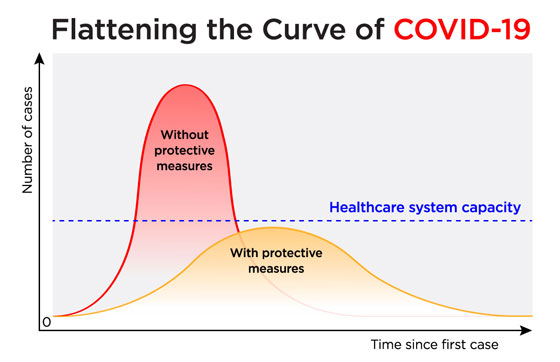 The key phrase that was used at the beginning of the pandemic is one that we need to keep going back to. We need to ensure that we flatten the curve. We need to ensure that — whatever happens — we don’t overwhelm the health care system to the point that public health can’t help us.
The key phrase that was used at the beginning of the pandemic is one that we need to keep going back to. We need to ensure that we flatten the curve. We need to ensure that — whatever happens — we don’t overwhelm the health care system to the point that public health can’t help us.
At the beginning this meant that we needed to watch the case count. We didn’t know what to expect. The medical experts, worldwide, were struggling to identify, contain, and treat this virus. We saw it spread around the world in a matter of months, despite all efforts to contain it. We saw significant lockdowns in Italy and France because hospitals were overwhelmed. We saw resources run out, and so doctors had to make decisions on who got medical resources and who didn’t (this put doctors in a position of deciding who lived and who died, and that is a place that they never want to be).
The virus has evolved. We’ve seen a number of variants come and go. Over time they seem to spread more and kill fewer. A recent article on healthline.com (https://www.healthline.com/health-news/what-we-can-learn-from-the-1918-flu-pandemic-as-the-omicron-variant-spreads) discusses this as well.
What this seems to mean, with COVID, is that we have to keep an eye on the number of people in the hospital because of COVID, and not the number of positive cases. When we are looking at the trend of those in the hospital we have to remember that it is lagging the actual condition by a couple of weeks. Today the number of people in the hospital with COVID is 34 (from here: https://experience.arcgis.com/experience/204d6ed723244dfbb763ca3f913c5cad) and this number is still going up.
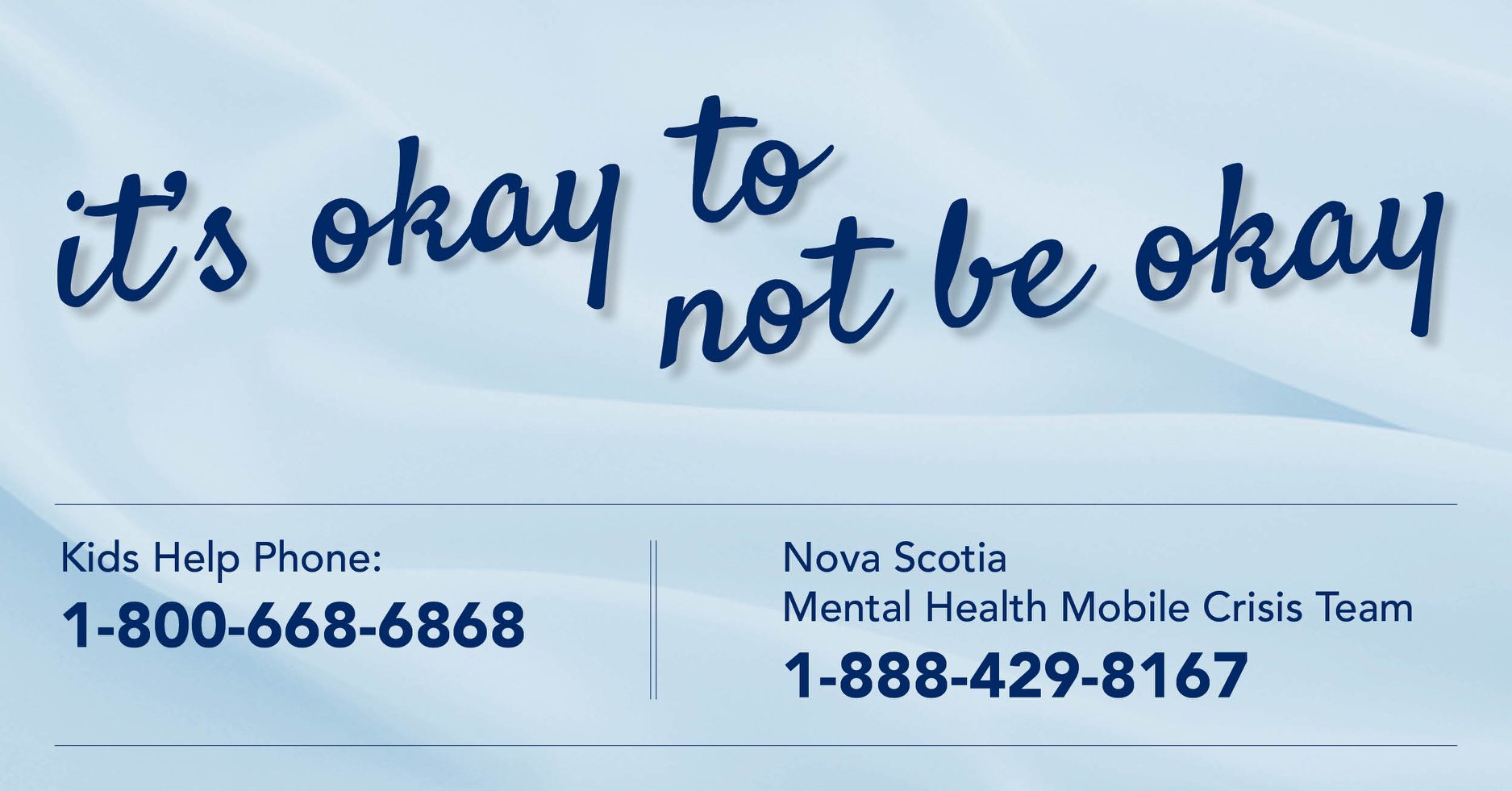 We’re tired of it. But we need to keep adhering to the measures of public health. We need to keep wearing masks, social distancing, and staying home.
We’re tired of it. But we need to keep adhering to the measures of public health. We need to keep wearing masks, social distancing, and staying home.
It’s not going to be easy, but it is required. If you need help then please reach out. There are many resources who are able to help. I’ve listed some of the resources on my web site here: http://www.paulrussell.ca/helpful-contact-information/
Recent Population Growth
The Halifax Partnership is the economic development agency in Halifax. They have done some modelling about population growth in Halifax (here: https://halifaxpartnership.com/research-strategy/halifax-index-2021/people/). I’m using some of the charts that they have created because they illustrate where I think we’re going.
The following chart shows that Halifax has seen the population growing by about 2% per year for each of the past 5 years (this is despite the housing crisis). Late in November the Halifax Partnership reviewed some preliminary data from Statistics Canada which shows that 2021 may be growing even faster — at 2.5%. This is despite the fact that our borders are effectively closed.
We expect the population to continue to grow by at least 2%, or more, for the foreseeable future.
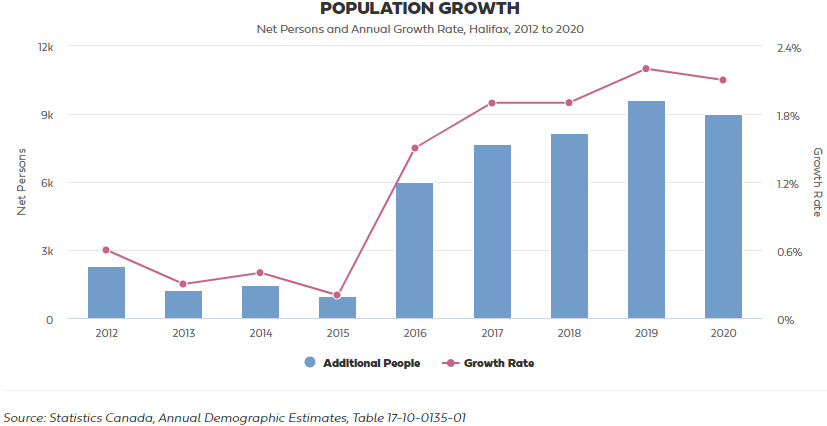
A couple of decades ago we heard about Nova Scotians moving to other parts of Canada to seek work. About 5 years ago we heard about Nova Scotians (still living in the province but outside of HRM) moving to HRM. Both of those trends have stopped.
The following chart shows that most of the population growth in Halifax has come internationally. People are seeing Canada, and Nova Scotia, and Halifax, as a very good place to live, and they are moving here in record numbers. (Natural growth, in the chart below, is calculated as: births minus deaths.)
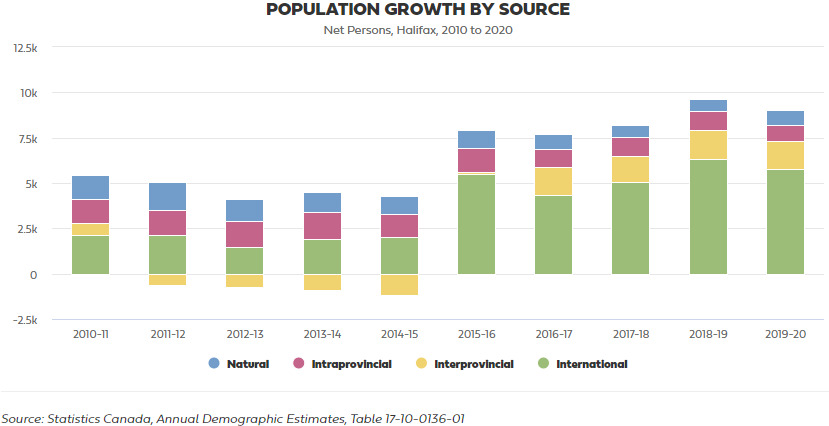
One Million Nova Scotians by 2060
Halifax has almost 500,000 people, and Nova Scotia has just surpassed a population of 1 million. If we increase in population by 2% per year for the next 40 years then by 2060 our population will double. Halifax will have 1 million people, and Nova Scotia will have 2 million people.
With our population doubling, we also have to look at doubling all of our infrastructure:
- Housing
- Transportation (roads and mass transit)
- Communication (internet service and cell service and phone service)
- Water / Storm Water / Waste Water
- Electricity
- Garbage / Recycling
We will also have to double our social services:
- Health Care
- Education (public school, and post secondary)
We have to start working on that now, both as a municipality and as a province, and we have to do this despite the challenges that COVID brings.
Housing (and housing risk)
I’ve previously written about housing here: http://www.paulrussell.ca/housing and am keeping that updated. There is some crossover, however, with this post.
Two of the key challenges that we face is housing capacity and housing cost.
In January the CMHC released its rental market report (here: https://assets.cmhc-schl.gc.ca/sites/cmhc/data-research/publications-reports/rental-market-reports/2020/rental-market-report-69720-2020-en.pdf?rev=936ca622-a6c5-4cbc-b937-d29b1d63cc14). This shows that – as of January – Halifax had a vacancy rate of 1.9% and that the average rent of a two bedroom apartment was $1,255 per month. That was in January.
Rent Donkey (http://www.rentdonkey.ca) is a web site that is often used to find apartment rentals. For a 2 bedroom apartment in downtown Halifax it currently has 16 listings, and the prices range from 1,200 to 2,850 per month. It does not list any 2 bedroom apartments in Sackville.
The lack of housing, and the lack of affordable housing, have exacerbated the housing crisis. Those who at a high risk of losing their home have no place to go, and so they end up couch surfing or on the street (“living rough” is often used to describe the homeless).
We need more housing, and we need it now
The two aspects of building housing are a) getting the plans approved, and b) getting the housing built.
At HRM we have recently digitized our planning process. It used to be manual, and we were working towards computerizing it. At the beginning of COVID the computerized system wasn’t ready and so we stood up a very temporary solution. We have now implemented the first version of the computerized system and we are working through the challenges with it. We are also working towards having the right amount of planning staff in order to have the planning department be more responsive. This is a work in progress.
We currently have issued residential construction permits for 4,600 units. This will take care of the population increase for a little more than one year. There are also plans in the works for over 87,000 more units. We need to get these moved through the system but, with a shortage of planning staff, this is taking longer than normal.
Once the plans have been approved, the developer needs to have the right construction team and the right construction materials.
COVID has had a huge impact on the amount of construction materials. At the beginning there was a shortage of materials because shipping had stopped. Then, since everyone was working from home, there was a shortage because homeowners were working on a lot of projects that they had put off. It took about a year, but there now seems to be enough lumber. There still seems to be a shortage of other materials, however, and I have heard that this is related to workers at supply production companies having COVID or not being able to work due to lockdowns. This will ease up over time.
Once the developer has the construction materials, the right construction workers are required.
We currently have a shortage of skilled and unskilled labour. I am certain that some of this, but only some of it, is due to COVID. Once we have passed the time where COVID is causing a shortage, we will still need more workers. Our post secondary institutions, like the NSCC, need to expand their trades capacity. We need more carpenters, electricians, plumbers, and other workers across the rest of the construction industry. This is going to take years to overcome, so we need to start that training now.
Affordable Housing
A two bedroom apartment, as mentioned above, costs between 1,200 and 2,850 per month. This is simply not affordable by most people. We need to have housing that is more affordable.
One way to help this is to have more housing. With a higher vacancy rate there will be more options for people to get housing, and so the market will help set the rate. While this will have an impact on the cost, I believe that the effect of that will be small.
Another way is to allow more density bonusing. This allows for a landlord to build additional units in an apartment building, but requires that those units are marketed as “affordable units”. The income that the landlord would lose on each additional unit would be made up by having many additional units. This program exists in the Regional Centre of HRM, and we are working to bring it to areas outside the Regional Centre.
Shelters / Warming Centres
Additional shelters and warming centre capacity is also required across HRM. The issues of housing insecurity and homeless will never go away, so we need to be able to accommodate those who need it. We already have some shelters in the downtown core, and we have a few warming centres around HRM. We are also working to build modular housing, and the archdiocese has also helped out by having suitable and safe temporary shelters, but more needs to be done. We need to recognize, as a municipality and as a province, that shelters and warming centres are needed across the municipality and across the province.
Some of this can be solved quickly, but a lot of it is going to take time to solve.
Transportation
One of the most important things that we do is make it easier for people move around.
Transportation Priorities
The Integrated Mobility Plan (here: https://www.halifax.ca/about-halifax/regional-community-planning/transportation-planning) defines a hierarchy of transportation importance with a pedestrian or cyclist as the highest priority, and a singe person in a single car as the lowest priority. That’s a great concept, and we now have to implement it.
For about 70 years Sackville has been cut off from the rest of Halifax, except by vehicle, by the 102. In that time we have developed a car mentality. Now, with the Bedford Sackville Greenway Trail and at Exit 4C on the 102, we are able to legally walk between Bedford and Sackville.
We will need time to change that mentality.
In my view it is a two step process. Step 1 is to make it easier to move without a car by having better transit or better active transportation routes. Step 2 is to make it more difficult to move with a car. In a lot of ways we are working on Step 2 before we have worked on Step 1.
Halifax Transit
HRM recently completed an overhaul of the transit system, in Sackville, with the Moving Forward Together Plan (here: https://www.halifax.ca/transportation/halifax-transit/moving-forward-together). This took the previous system, assumed that it didn’t exist, and made determinations about where the system should go. Transit then made the necessary adjustments to the routes to make it fit that. In many cases it worked, although there is still room for improvement across the board.
I will be working with Halifax Transit, early in the new year, to identify where there are still challenges and things that can be improved.
I am also working to make sure that the system is more available and more reliable. It has to get us from where we are (or close) — to where we want to go (or close) — when it says it will, and it can’t take too long to get there. We also have to be able to pay for it, which means that we always have to make sure that it accepts cash.
Roads
The road network in HRM is our single most valuable asset. It connects everything to everything else. We need to make sure that it is a good state of repair all the time.
We measure the condition of the paved roads in HRM using a number of metrics, one of which is the Pavement Condition Index (PCI). This is on a scale of 0 to 100, where 0 is the worst possible shape where there is no integrity left to the paving, and 100 is the best possible shape where (for instance) it was just paved yesterday. The chart, below, shows the PCI over time.
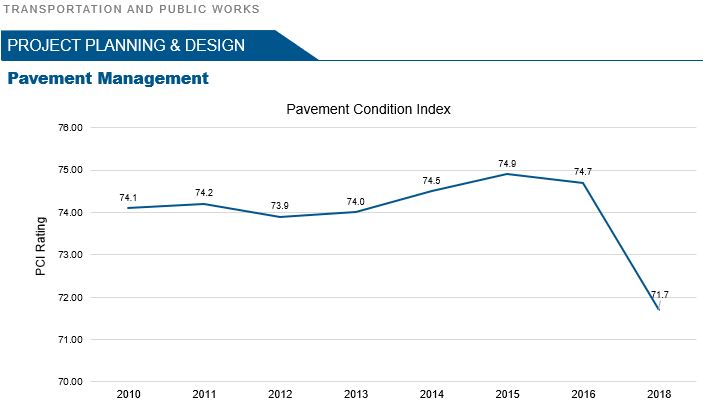
This chart shows that the condition of the road network was holding steady for a number of years but, with release of the Integrated Mobility Plan, started to decline. One of the effects of the IMP is that we started to design for “complete streets”, and road structures became more complex.
A million dollars, in 2010, was able to pave many more road kilometres than a million dollars in 2020.
I am working to make sure that we (in Lower Sackville) are getting the right roadwork done, so that the condition of our streets remains good. This year (for the 2022/23 budget year) I was working to ensure that streets like Polara Drive were paved, and it’s currently in the budget list. You can see that on page 188 of the capital budget (here: https://www.halifax.ca/sites/default/files/documents/city-hall/budget-finances/2022-23%20Draft%20Capital%20Plan.pdf). Next year I’m going to be working to ensure that streets like Tilley Court, Leaside Drive, and Seawood Ave are repaved.
Sidewalks
I am continuing to work on sidewalks. About 50 years ago the province embarked on a housing initiative and developed most of Cole Harbour and Lower Sackville. At the time a network of streets was built so that housing could be built, but the standards were different, at that time, so no sidewalks were built for those streets. The regional centre of HRM was already built and had sidewalks, and development standards have since changed so that streets are now built with sidewalks, but we have a lot of streets that fell through that very wide gap and have no sidewalks.
I started to identify places where sidewalks were required even before I was elected, and I am continuing to work to get them built.
The top three sidewalks that I would like to see built are (in no particular order)
- Old Beaver Bank Road. There is work, this year, to review the most difficult part of that road — the bridge near Glendale — to check what shape it is in and to do some design work to improve it.
- Cobequid Road, from Sucker Brook Road to First Lake Drive. This year we expect that section of Cobequid Road to be resurfaced, and we expect a paved shoulder to be added to the west side of the road.
- Stokil Drive, in front of a dozen houses that are between the two schools. This year we will be adding speed humps to that area of the street, but I am continuing to push for sidewalks so that children don’t have to walk on a narrow street to get to school.
The next street on my list is Riverside Drive. This is too wide, and so cars drive too quickly. By having a sidewalk on both sides, narrowing the street, drivers will naturally slow down.
Bike Lanes
Through the elections in 2019 and 2020 only one person mentioned bike lanes for Lower Sackville.
My observations were that those in Lower Sackville used bikes for recreation and exercise, but not for day-to-day or home-to-work transportation. We are still in a very vehicle-centric location.
In the past couple of months, however, a few people have mentioned bike lanes, and that they should be added to our streets here.
I am still considering bike lanes, but am not moving forward on them yet. I would like to hear from a number of other people before I move forward on them.
Recreation
Sackville is wonderful. We are close to everything, and we are far away from everything. We have the right population density to make us a community, without it being so dense that we feel like we’re in downtown Halifax. This is a good place to work, a good place to shop, and a great place to live.
One of the great things about living here is the amount of things that we have for recreation. This includes the many parks and trails, First Lake, and the recreation facilities.
As with everything else, however, these can all be improved. I’m working on that.
First Lake Testing
First Lake is a gem. It’s beautiful to look at. It should also be great to swim in.
For years the Kinsmen Beach at First Lake has had a pollution problem. When there was a lifeguard there the beach was closed more often than it was open. Then the lifeguard was pulled because they were operating more as a security guard than a lifeguard. Then they stopped testing the lake. This is one of the reasons that I wanted to become a Councillor in the first place — to fix the problem at the lake.
We’ve known that there was a problem at First Lake, but we didn’t know where it was or the source of it. This year we made great progress at determining both of those.
In the 2020/21 budget, we approved spending $150K to have the source of the e.coli identified. This would perform an analysis of the e.coli to determine if it was human (from, perhaps, a leaky sewer) or pet (from, perhaps, stormwater that was going in to the lake) or water fowl or something else like deer. This testing is scheduled to happen in the summer of 2022. We then needed to know where to test.
Through the summer and fall of 2021, we (the Friends of First Lake – water stewardship committee, more specifically Janey Hughes and Allan Tattrie) started to test various locations on First Lake for a) general lake health and b) total coliforms and e.coli. I provided funding for any testing that was necessary, and have committed to do that as long as I am the Councillor. This testing happened despite COVID interfering and the difficulty of getting equipment beforehand and then getting the analysis done afterwards.
The data that Janey got back was fantastic and identified exactly what I hoped it would. The figures are still preliminary and are awaiting final confirmation of some measurements, so we can’t publish them yet. That being said, we are absolutely certain that we know where the problem is.
Once we know where the problem is and what it is, the next step is to fix it. Council has already indicated a willingness to move forward with this, which I’m absolutely thrilled with.
We have this amazing lake in our community. We should be able to use it. I’m working hard to make sure that we can.
Sackville Sports Stadium
The Sackville Sports Stadium was built in 1990 and received one expansion about 10 years later. Other than that it has seen routine maintenance work.
Since it was first built our community has grown and our needs have evolved. It still serves the purposes that it was originally built for, but it should be able to do more.
This year (in 2021) I started the process to see if we could expand the Sports Stadium so that it could satisfy the growing needs of our community. A survey was conducted and received over 1,700 responses (…which is amazing! Thank you to all who responded!). The responses from that survey are being analyzed now, and we expect to receive a report back to Regional Council in October 2022 about what that expansion should look like. Should we expand the pool? Should we have a new gym / court? Should we have an indoor field for something like soccer? Should we have a boat launch and add lake programming? Should the entire property be made more accessible?
I’m looking forward to see what we can do for the next phase of the Stadium.
Sackville Greenway Trail
We have a number of trails through Sackville. One collection of them is the Sackville Greenway Trail. The current segment of the Sackville Greenway Trail goes from Sackville Drive to Glendale Drive parallel to Old Beaver Bank Road.
More work is expected on this system in the next while:
We are looking to add an accessible trailhead to the middle of the current segment. We aren’t sure exactly where that will go, but it most likely will be built behind the Lions Hall on Old Beaver Bank Road. This is still very early in the planning stages. This is a collaboration with Sackville Rivers, the Lions, and HRM.
We are looking to build the trail from the Old Sackville Road to Sackville Drive. Development of the first half of this is being done as part of the agreement with the new apartment buildings on Old Sackville Road. Once that development is complete, we will pick it up and build it the rest of the way to Sackville Drive. I met with the property developer about this a few times this year. This is a collaboration between the developer and HRM.
We are looking to extend the trail from the Bedford Sackville Trail and Fultz House up to the Sackville Bus Terminal. This is currently in the concept and design phase, but it looks promising. I met with the designer about this earlier this month. This is being spearheaded by Sackville Rivers at this point, although HRM is providing some background information.
When this set of trails is complete, we will have an accessible trail system that extends from Glendale Drive to Sackville Drive to Old Sackville Road to Fultz House to Bedford.
First Lake Trail
A number of years ago the Friends of First Lake built a trail that extends from behind the Sports Stadium, around by the Sackville Arena, the Sackawa canoe club, along the First Lake Drive side of the lake, to Sucker Brook Road. It covered all of the HRM and provincial land that it could. This has proven to very successful and incredibly popular.
This year construction started on the “south side” trail, which covers the HRM land along Chandler Drive and Johnson Cres. One segment was completed this year, and future segments are planned over the next few years.
I am pleased to support this trail development. I look forward to the completion of the trail in another few years.
The Sackville Greenway Trail system provides a paved trail for all users. The First Lake Trail provides a maintained but unpaved trail for those who prefer that.
Conclusion
There is a huge amount going on in Lower Sackville, around HRM, and across the province. This is helping to make our community an even better place to live.
 Although this has been an incredibly difficult couple of years, we do have a positive future. We just have to recognize it, to keep it in mind constantly, and to work towards it.
Although this has been an incredibly difficult couple of years, we do have a positive future. We just have to recognize it, to keep it in mind constantly, and to work towards it.
There are many people, across our community, who are working hard on a number of initiatives, many of which I’ve listed here. As COVID dies down, and our world begins to open up again, many of our community groups could use some help. Getting involved with them could be the best way to stay positive and get reconnected with our community as a whole.
I am looking forward to the future, and I hope that you are too.
Happy New Year! I wish you the very best in 2022!
